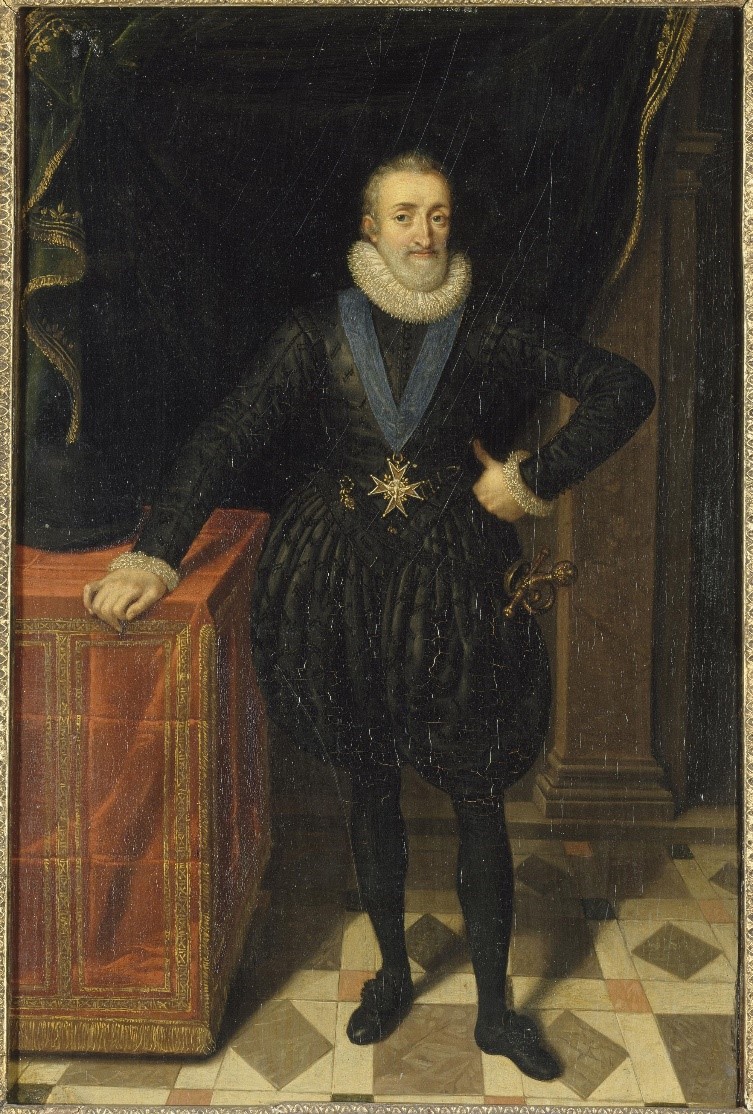The Conversion of Henri IV of France
Chapter 5 : The Moment of Truth
At ten o’clock in the morning of Sunday 25th July 1593, Henri IV set off in a procession to the abbey church of St Denis, the royal necropolis of France. He was dressed in black and white: a doublet of white with gold brocade, white stockings, a black cape, a black plumed hat, black shoes. He wore his sword, but no other emblem of royalty. He was on foot.[1]
The simple penitent was preceded by two hundred archers, five hundred guardsmen, eight hundred gentlemen of the household. twelve trumpeters, the master of ceremonies and the Chancellor of France. Behind the King walked the Bourbon princes, assorted nobles, the Knights of the Orders of St Michel and the St Esprit and countless others. The procession walked over a carpet of flowers cast by the crowds who had come to witness the return of the King.
On the church steps Henri IV took off his hat and sword. He walked alone up the steps to face Archbishop de Beaune, who sat in a chair carved with the royal arms, both France and Navarre. Other clerics stood at Renaud’s side, including the Cardinal de Vendôme.
‘Who are you?’ asked the archbishop.
‘I am the King.’
‘What do you want?’ asked the archbishop
‘I want to be received into the bosom of the Roman Catholic Church’
‘Do you wish to do it freely?’
‘Yes, I desire it freely,’ said the King.
From the porch of St Denis Henri IV then read out a formal statement of his recognition of the Catholic Church, including a vow of obedience to the Pope, and his abjuration of heresy.
Proceeding inside, Henri IV knelt at the altar, placed his hands on a bible, and swore to live and die a Catholic. The congregation proclaimed the King with a shout of ‘Vive le Roi!’ Henri IV made the sign of the cross and embraced the altar. He confessed his sins to Beaune, who absolved the King, and instructed him to undertake acts of penance that would show he was truly repentant. Nobody else heard the confession or knew the penance – the usual Catholic practice.
During the Mass Henri IV sat on a dais covered with velvet brocade, embroidered with white fleurs-de-lis. Having renounced heresy, having confessed his sins, the King was now given the traditional emblem of French royalty, the lily. It symbolised his acceptance as Catholic King of France.
His religious status was recognized when he kissed the bible after the gospel reading. In a normal Mass this was the priest’s job. The King’s priest-like function was also emphasised in the Holy Eucharist. Like the priests he took Communion under both kinds, bread and wine (the laity only took bread).[2]
At the moment of Communion, the crowds outside saw a large flock of white doves soar above the abbey church, released from the St Denis belfry. The dove was the emblem of the Holy Spirit - God’s presence in the world – and of peace.

Although the Huguenots felt betrayed by Henri IV he did not abandon them. Early that morning in St Denis, before he dressed for the abjuration, the king received alone in his room a Huguenot minister called la Faye. He reassured his Protestant friend that he would never permit violence against the Huguenots.[3] Five years later, in April 1598, he kept his word when he announced the Edict of Nantes, which proclaimed Catholicism the religion of France, but permitted Huguenots freedom of conscience and rights to worship as they chose in many parts of France (not Paris).
Henri IV was crowned King of France in a Catholic service at Chartres, on 17th February 1594. On 22nd March he took possession of a still rather reluctant Paris, but he did so relatively peacably. With even greater reluctance Pope Clement VIII absolved Henri IV of the sin of heresy and accepted him as a full member of the Roman Catholic Church on 22nd September 1595.
Civil war does not easily die. There were plenty who protested at Henri IV’s conversion. His enemies claimed he was insincere – a fake conversion was an ever greater accumulation of sin.[4] On the other hand Elizabeth I of England greeted it with dismay of another sort writing ‘Oh what griefs, what regrets, what groanings felt I in my soul at the sound of such news…’[5] Philip II continued to fund the League, and supported the Duke of Mercoeur who wanted to make Brittany an independent state. From 1595 the Wars of Religion merged with a formal declaration of war by Henri IV on Spain. Nonetheless most French accepted that Henri IV, in becoming Catholic, had taken the first step to heal France. Mercoeur was finally subdued in March 1598. Philip II died five months after the Edict of Nantes – which he detested - having failed to remake France in his image, just as he failed to remake England earlier.
Nobody can read the heart of Henri IV today, but as a sixteenth century man he was certainly religious, God-fearing. His conversion looks like a purely political decision for obvious reasons, yet there is no doubt that he experienced a severe inner struggle as he wrestled with the options - indeed with the theology and the codes of Catholicism. The salvation he sought was that of his country as much as that of his soul. The former, at least, we know he achieved. The French state survived thanks to Henri IV. It is one of history’s great achievements.
[1] For the narrative see Palma Cayet Chronologie Novenaire (Paris 1836) – also Wolfe pp 146-154.
[2] Communion under both kinds was also Protestant practice.
[3] Wolfe p 147 quoting Pierre de l’Estoile
[4] He had converted briefly earlier in the period 1572 to 1576
[5] Elizabeth I Collected Works (University of Chicago 2000) p 370














